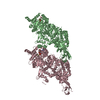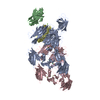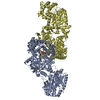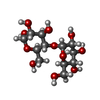+ Open data
Open data
- Basic information
Basic information
| Entry | Database: PDB / ID: 6gfj | |||||||||
|---|---|---|---|---|---|---|---|---|---|---|
| Title | Structure of RIP2 CARD domain fused to crystallisable MBP tag | |||||||||
 Components Components | Sugar ABC transporter substrate-binding protein,Receptor-interacting serine/threonine-protein kinase 2 | |||||||||
 Keywords Keywords | TRANSFERASE / CARD / crystallographic MBP / RIP2 / Death Domain | |||||||||
| Function / homology |  Function and homology information Function and homology informationresponse to interleukin-18 / toll-like receptor 2 signaling pathway / positive regulation of T-helper 1 cell differentiation / positive regulation of cytokine-mediated signaling pathway / immature T cell proliferation in thymus / positive regulation of T-helper 1 type immune response / positive regulation of xenophagy / caspase binding / xenophagy / LIM domain binding ...response to interleukin-18 / toll-like receptor 2 signaling pathway / positive regulation of T-helper 1 cell differentiation / positive regulation of cytokine-mediated signaling pathway / immature T cell proliferation in thymus / positive regulation of T-helper 1 type immune response / positive regulation of xenophagy / caspase binding / xenophagy / LIM domain binding / positive regulation of protein K63-linked ubiquitination / nucleotide-binding oligomerization domain containing 1 signaling pathway / cellular response to muramyl dipeptide / positive regulation of stress-activated MAPK cascade / CARD domain binding / positive regulation of immature T cell proliferation in thymus / CD4-positive, alpha-beta T cell proliferation / JUN kinase kinase kinase activity / cellular response to peptidoglycan / response to interleukin-12 / positive regulation of CD4-positive, alpha-beta T cell proliferation / nucleotide-binding oligomerization domain containing 2 signaling pathway / positive regulation of macrophage cytokine production / positive regulation of peptidyl-tyrosine phosphorylation / toll-like receptor 4 signaling pathway / response to exogenous dsRNA / cellular response to lipoteichoic acid / positive regulation of interferon-alpha production / carbohydrate transmembrane transporter activity / maltose binding / canonical NF-kappaB signal transduction / maltose transport / maltodextrin transmembrane transport / p75NTR recruits signalling complexes / stress-activated MAPK cascade / ATP-binding cassette (ABC) transporter complex, substrate-binding subunit-containing / positive regulation of chemokine production / JNK cascade / JNK (c-Jun kinases) phosphorylation and activation mediated by activated human TAK1 / positive regulation of protein ubiquitination / ERK1 and ERK2 cascade / signaling adaptor activity / positive regulation of interleukin-12 production / positive regulation of interleukin-2 production / activated TAK1 mediates p38 MAPK activation / response to interleukin-1 / positive regulation of interferon-beta production / lipopolysaccharide-mediated signaling pathway / positive regulation of interleukin-1 beta production / NOD1/2 Signaling Pathway / TAK1-dependent IKK and NF-kappa-B activation / non-membrane spanning protein tyrosine kinase activity / positive regulation of JNK cascade / non-specific protein-tyrosine kinase / protein homooligomerization / Interleukin-1 signaling / positive regulation of interleukin-6 production / positive regulation of type II interferon production / Ovarian tumor domain proteases / cytokine-mediated signaling pathway / positive regulation of tumor necrosis factor production / Downstream TCR signaling / T cell receptor signaling pathway / vesicle / adaptive immune response / cytoskeleton / positive regulation of ERK1 and ERK2 cascade / positive regulation of canonical NF-kappaB signal transduction / non-specific serine/threonine protein kinase / defense response to Gram-positive bacterium / defense response to bacterium / positive regulation of apoptotic process / inflammatory response / signaling receptor binding / innate immune response / protein serine kinase activity / protein serine/threonine kinase activity / apoptotic process / SARS-CoV-2 activates/modulates innate and adaptive immune responses / endoplasmic reticulum / signal transduction / protein homodimerization activity / positive regulation of transcription by RNA polymerase II / protein-containing complex / ATP binding / identical protein binding / plasma membrane / cytosol / cytoplasm Similarity search - Function | |||||||||
| Biological species |  Methanosarcina mazei (archaea) Methanosarcina mazei (archaea) Homo sapiens (human) Homo sapiens (human) | |||||||||
| Method |  X-RAY DIFFRACTION / X-RAY DIFFRACTION /  SYNCHROTRON / SYNCHROTRON /  MOLECULAR REPLACEMENT / Resolution: 3.3 Å MOLECULAR REPLACEMENT / Resolution: 3.3 Å | |||||||||
 Authors Authors | Pellegrini, E. / Cusack, S. | |||||||||
 Citation Citation |  Journal: Nat Commun / Year: 2018 Journal: Nat Commun / Year: 2018Title: RIP2 filament formation is required for NOD2 dependent NF-κB signalling. Authors: Erika Pellegrini / Ambroise Desfosses / Arndt Wallmann / Wiebke Manuela Schulze / Kristina Rehbein / Philippe Mas / Luca Signor / Stephanie Gaudon / Grasilda Zenkeviciute / Michael Hons / ...Authors: Erika Pellegrini / Ambroise Desfosses / Arndt Wallmann / Wiebke Manuela Schulze / Kristina Rehbein / Philippe Mas / Luca Signor / Stephanie Gaudon / Grasilda Zenkeviciute / Michael Hons / Helene Malet / Irina Gutsche / Carsten Sachse / Guy Schoehn / Hartmut Oschkinat / Stephen Cusack /    Abstract: Activation of the innate immune pattern recognition receptor NOD2 by the bacterial muramyl-dipeptide peptidoglycan fragment triggers recruitment of the downstream adaptor kinase RIP2, eventually ...Activation of the innate immune pattern recognition receptor NOD2 by the bacterial muramyl-dipeptide peptidoglycan fragment triggers recruitment of the downstream adaptor kinase RIP2, eventually leading to NF-κB activation and proinflammatory cytokine production. Here we show that full-length RIP2 can form long filaments mediated by its caspase recruitment domain (CARD), in common with other innate immune adaptor proteins. We further show that the NOD2 tandem CARDs bind to one end of the RIP2 CARD filament, suggesting a mechanism for polar filament nucleation by activated NOD2. We combine X-ray crystallography, solid-state NMR and high-resolution cryo-electron microscopy to determine the atomic structure of the helical RIP2 CARD filament, which reveals the intermolecular interactions that stabilize the assembly. Using structure-guided mutagenesis, we demonstrate the importance of RIP2 polymerization for the activation of NF-κB signalling by NOD2. Our results could be of use to develop new pharmacological strategies to treat inflammatory diseases characterised by aberrant NOD2 signalling. | |||||||||
| History |
|
- Structure visualization
Structure visualization
| Structure viewer | Molecule:  Molmil Molmil Jmol/JSmol Jmol/JSmol |
|---|
- Downloads & links
Downloads & links
- Download
Download
| PDBx/mmCIF format |  6gfj.cif.gz 6gfj.cif.gz | 715.1 KB | Display |  PDBx/mmCIF format PDBx/mmCIF format |
|---|---|---|---|---|
| PDB format |  pdb6gfj.ent.gz pdb6gfj.ent.gz | 608 KB | Display |  PDB format PDB format |
| PDBx/mmJSON format |  6gfj.json.gz 6gfj.json.gz | Tree view |  PDBx/mmJSON format PDBx/mmJSON format | |
| Others |  Other downloads Other downloads |
-Validation report
| Summary document |  6gfj_validation.pdf.gz 6gfj_validation.pdf.gz | 1.7 MB | Display |  wwPDB validaton report wwPDB validaton report |
|---|---|---|---|---|
| Full document |  6gfj_full_validation.pdf.gz 6gfj_full_validation.pdf.gz | 1.7 MB | Display | |
| Data in XML |  6gfj_validation.xml.gz 6gfj_validation.xml.gz | 58.1 KB | Display | |
| Data in CIF |  6gfj_validation.cif.gz 6gfj_validation.cif.gz | 79.5 KB | Display | |
| Arichive directory |  https://data.pdbj.org/pub/pdb/validation_reports/gf/6gfj https://data.pdbj.org/pub/pdb/validation_reports/gf/6gfj ftp://data.pdbj.org/pub/pdb/validation_reports/gf/6gfj ftp://data.pdbj.org/pub/pdb/validation_reports/gf/6gfj | HTTPS FTP |
-Related structure data
| Related structure data |  4399C  6ggsC  4ifpS S: Starting model for refinement C: citing same article ( |
|---|---|
| Similar structure data |
- Links
Links
- Assembly
Assembly
| Deposited unit | 
| ||||||||||||||||||||||||||||||||||||||||||||||||||||||||||||||||||||||||||||||||||||||||||||||||||||||||||||||||||||||||||||||||||||||||||||||||||||||||||||||||||||||||||||||||||||||||||||||||||||||||||||||||||||||||||||||||||||||||||||||
|---|---|---|---|---|---|---|---|---|---|---|---|---|---|---|---|---|---|---|---|---|---|---|---|---|---|---|---|---|---|---|---|---|---|---|---|---|---|---|---|---|---|---|---|---|---|---|---|---|---|---|---|---|---|---|---|---|---|---|---|---|---|---|---|---|---|---|---|---|---|---|---|---|---|---|---|---|---|---|---|---|---|---|---|---|---|---|---|---|---|---|---|---|---|---|---|---|---|---|---|---|---|---|---|---|---|---|---|---|---|---|---|---|---|---|---|---|---|---|---|---|---|---|---|---|---|---|---|---|---|---|---|---|---|---|---|---|---|---|---|---|---|---|---|---|---|---|---|---|---|---|---|---|---|---|---|---|---|---|---|---|---|---|---|---|---|---|---|---|---|---|---|---|---|---|---|---|---|---|---|---|---|---|---|---|---|---|---|---|---|---|---|---|---|---|---|---|---|---|---|---|---|---|---|---|---|---|---|---|---|---|---|---|---|---|---|---|---|---|---|---|---|---|---|---|---|---|---|---|---|---|---|---|---|---|---|---|---|---|---|
| 1 |
| ||||||||||||||||||||||||||||||||||||||||||||||||||||||||||||||||||||||||||||||||||||||||||||||||||||||||||||||||||||||||||||||||||||||||||||||||||||||||||||||||||||||||||||||||||||||||||||||||||||||||||||||||||||||||||||||||||||||||||||||
| Unit cell |
| ||||||||||||||||||||||||||||||||||||||||||||||||||||||||||||||||||||||||||||||||||||||||||||||||||||||||||||||||||||||||||||||||||||||||||||||||||||||||||||||||||||||||||||||||||||||||||||||||||||||||||||||||||||||||||||||||||||||||||||||
| Noncrystallographic symmetry (NCS) | NCS domain:
NCS domain segments:
NCS ensembles :
|
- Components
Components
| #1: Protein | Mass: 52665.781 Da / Num. of mol.: 4 Source method: isolated from a genetically manipulated source Source: (gene. exp.)  Methanosarcina mazei (archaea), (gene. exp.) Methanosarcina mazei (archaea), (gene. exp.)  Homo sapiens (human) Homo sapiens (human)Strain: K12 Gene: malE, DU74_04045, RIPK2, CARDIAK, RICK, RIP2, UNQ277/PRO314/PRO34092 Production host:  References: UniProt: A0A0F8NYV9, UniProt: O43353, non-specific serine/threonine protein kinase, non-specific protein-tyrosine kinase #2: Polysaccharide | alpha-D-glucopyranose-(1-4)-alpha-D-glucopyranose / alpha-maltose |
|---|
-Experimental details
-Experiment
| Experiment | Method:  X-RAY DIFFRACTION / Number of used crystals: 1 X-RAY DIFFRACTION / Number of used crystals: 1 |
|---|
- Sample preparation
Sample preparation
| Crystal | Density Matthews: 3.05 Å3/Da / Density % sol: 59.61 % |
|---|---|
| Crystal grow | Temperature: 293 K / Method: vapor diffusion, sitting drop / Details: 0.25 M NaNO3, and 22% (w/v) PEG 3350 |
-Data collection
| Diffraction | Mean temperature: 100 K |
|---|---|
| Diffraction source | Source:  SYNCHROTRON / Site: SYNCHROTRON / Site:  ESRF ESRF  / Beamline: ID29 / Wavelength: 0.976 Å / Beamline: ID29 / Wavelength: 0.976 Å |
| Detector | Type: DECTRIS PILATUS3 6M / Detector: PIXEL / Date: Nov 23, 2015 |
| Radiation | Protocol: SINGLE WAVELENGTH / Monochromatic (M) / Laue (L): M / Scattering type: x-ray |
| Radiation wavelength | Wavelength: 0.976 Å / Relative weight: 1 |
| Reflection | Resolution: 3.29→46.98 Å / Num. obs: 37320 / % possible obs: 98.5 % / Redundancy: 3.8 % / Biso Wilson estimate: 131.5 Å2 / Rrim(I) all: 0.19 / Net I/σ(I): 5.45 |
| Reflection shell | Resolution: 3.29→3.38 Å / Rrim(I) all: 1.37 |
- Processing
Processing
| Software |
| ||||||||||||||||||||||||||||||||||||||||||||||||||||||||||||||||||||||||||||||||||||||||||||||||||||||||||||||||||||||||||||||||||||||||||||||||||||||||||||||||||||||||||||||||||||||
|---|---|---|---|---|---|---|---|---|---|---|---|---|---|---|---|---|---|---|---|---|---|---|---|---|---|---|---|---|---|---|---|---|---|---|---|---|---|---|---|---|---|---|---|---|---|---|---|---|---|---|---|---|---|---|---|---|---|---|---|---|---|---|---|---|---|---|---|---|---|---|---|---|---|---|---|---|---|---|---|---|---|---|---|---|---|---|---|---|---|---|---|---|---|---|---|---|---|---|---|---|---|---|---|---|---|---|---|---|---|---|---|---|---|---|---|---|---|---|---|---|---|---|---|---|---|---|---|---|---|---|---|---|---|---|---|---|---|---|---|---|---|---|---|---|---|---|---|---|---|---|---|---|---|---|---|---|---|---|---|---|---|---|---|---|---|---|---|---|---|---|---|---|---|---|---|---|---|---|---|---|---|---|---|
| Refinement | Method to determine structure:  MOLECULAR REPLACEMENT MOLECULAR REPLACEMENTStarting model: 4IFP Resolution: 3.3→46.98 Å / Cor.coef. Fo:Fc: 0.938 / Cor.coef. Fo:Fc free: 0.899 / SU B: 105.632 / SU ML: 0.645 / Cross valid method: THROUGHOUT / ESU R Free: 0.563 / Stereochemistry target values: MAXIMUM LIKELIHOOD / Details: HYDROGENS HAVE BEEN ADDED IN THE RIDING POSITIONS
| ||||||||||||||||||||||||||||||||||||||||||||||||||||||||||||||||||||||||||||||||||||||||||||||||||||||||||||||||||||||||||||||||||||||||||||||||||||||||||||||||||||||||||||||||||||||
| Solvent computation | Ion probe radii: 0.8 Å / Shrinkage radii: 0.8 Å / VDW probe radii: 1.2 Å / Solvent model: MASK | ||||||||||||||||||||||||||||||||||||||||||||||||||||||||||||||||||||||||||||||||||||||||||||||||||||||||||||||||||||||||||||||||||||||||||||||||||||||||||||||||||||||||||||||||||||||
| Displacement parameters | Biso mean: 129.1 Å2
| ||||||||||||||||||||||||||||||||||||||||||||||||||||||||||||||||||||||||||||||||||||||||||||||||||||||||||||||||||||||||||||||||||||||||||||||||||||||||||||||||||||||||||||||||||||||
| Refinement step | Cycle: 1 / Resolution: 3.3→46.98 Å
| ||||||||||||||||||||||||||||||||||||||||||||||||||||||||||||||||||||||||||||||||||||||||||||||||||||||||||||||||||||||||||||||||||||||||||||||||||||||||||||||||||||||||||||||||||||||
| Refine LS restraints |
|
 Movie
Movie Controller
Controller











 PDBj
PDBj














